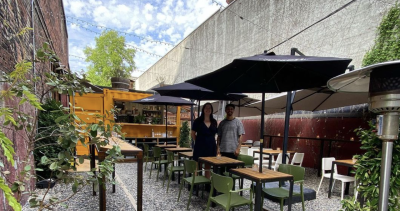Rainbow flag symbolizes soul of LGBT community
Rainbow flags are currently scattered across Vancouver in many forms, whether they be temporarily adorning the windows of various businesses, flapping outside Vancouver City Hall, or painted on the streets. But where did this now familiar symbol of queer empowerment come from?
The traditional LGBT Pride flag was created in 1978. It originally consisted of eight stripes but was eventually dropped to six. The flag was created by San Francisco–based queer artist Gilbert Baker for $1,000. Baker—who was originally from Kansas—never became a rich man because of the flag. He purposely chose not to copyright the flag so that it could be owned by everyone.
“A true flag is not something you can really design,” Baker told CBS in 2012. “A true flag is torn from the soul of the people. A flag is something that everyone owns, and that’s why they work. The rainbow flag is like other flags in that sense: it belongs to the people.”
In 1974, Baker met rising queer activist Harvey Milk in San Francisco. Milk would eventually become the first openly gay man elected to public office in California, in 1977. He famously rode under the original, eight-striped rainbow Pride flag in the San Francisco Gay Freedom Day Parade in June 1978. Milk was assassinated later that year.
In 1978, Baker enlisted the help of multiple people from the Gay Community Center on Grove Street in San Francisco to hand-stitch and hand-dye the very first rainbow flag. He chose the eight original colours through colour therapy. These particular colours held special meaning: bright pink symbolized sex; red symbolized life; orange symbolized healing; yellow symbolized sunlight; green symbolized nature; turquoise symbolized magic; blue symbolized serenity; and purple symbolized spirit.
“The rainbow is a part of nature, and you have to be in the right place to see it,” Baker told CBS. “It’s beautiful, all of the colours, even the colours you can’t see. That really fit us as a people because we are all of the colours. Our sexuality is all of the colours. We are all the genders, races, and ages.”
Eventually, high demand led to commercial production of the Pride flag. Because of production costs, pink and turquoise were dropped.
The rainbow flag was intended to replace the reclaimed pink triangle, which some saw as traditionally homophobic. In Nazi Germany, a pink triangle was used to mark those who were either presumed or openly gay; concentration-camp inmates imprisoned for homosexuality wore the upside-down triangle on their jackets.
Today there are many variations on the Pride flag. Little Sister’s Book and Art Emporium on Davie Street currently carries 16 different kinds. According to management, the transgender, bisexual, and gender-fluid flags are especially popular among customers. But the top seller? Always the traditional rainbow.
More














Comments